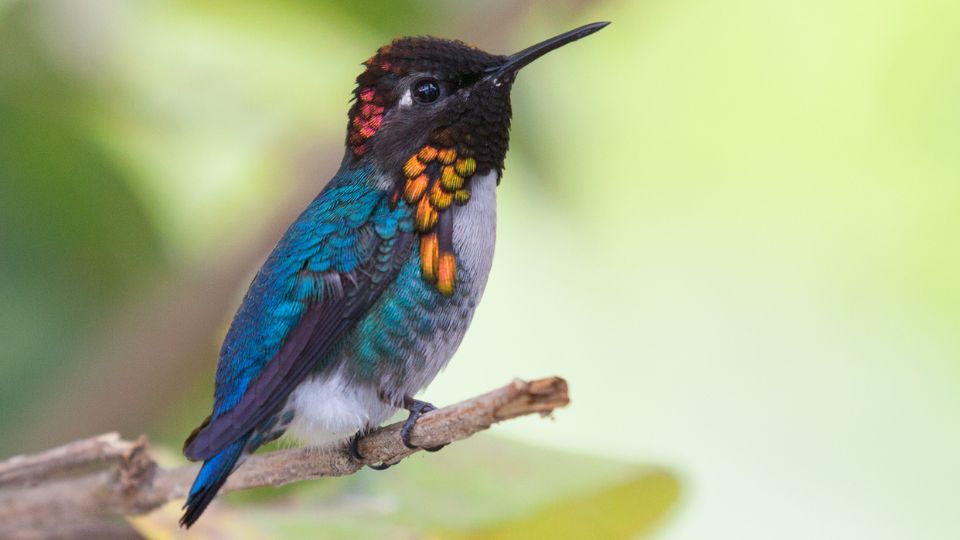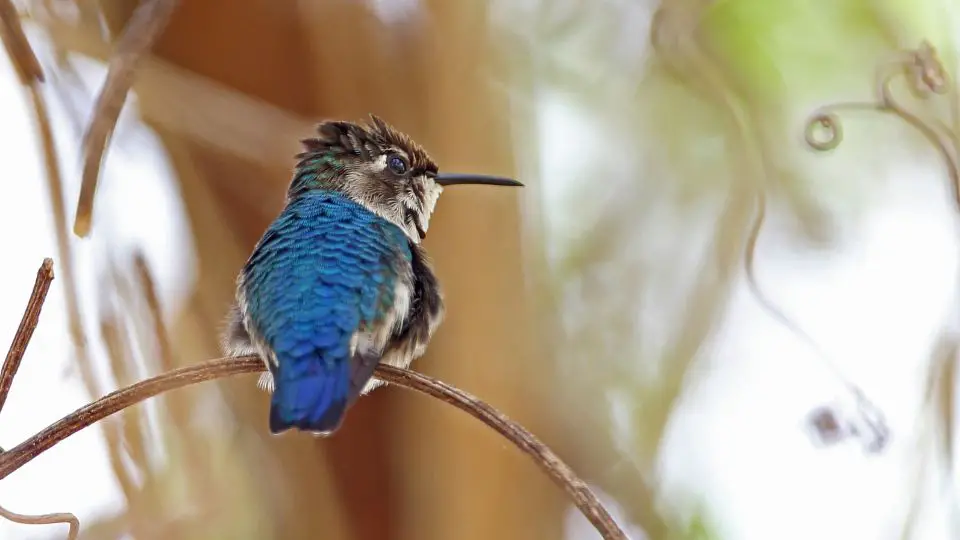Hummingbirds are tiny birds that are part of the Trochilidae family, but there are many different species – some are smaller, while others are bigger.
For example, the biggest species of hummingbirds is the giant hummingbird Patagonia Gigas (weighing 20 g and measuring 20cm), but other more common species like the Rivoli hummingbird are also bigger.
At the other end of the spectrum, the bee hummingbird (or Mellisuga helenae) is the world’s smallest bird! How small, you may wonder. Well, smaller than the size of a US penny. But don’t let its small stature fool you—the Bee Hummingbird is a fierce little creature!
Unlike other species, you don’t see the bee hummingbird in North America. Instead, you’d have to visit Cuba to spot some of them.
Unfortunately, the number of these hummers is declining more and more each year, so they are classified as threatened (See: The IUCN Red List). Their habitat keeps shrinking due to their territory being converted for agricultural uses.
That means you might not have the chance to see them around anymore.

Table of Contents
Facts about bee hummingbirds
The Bee Hummingbird is also called zunzuncito, Helena hummingbird, or Mellisuga helenae. It is a bird species endemic to the Cuban archipelago ( in the Caribbean). That includes the island of Cuba & Isla de la Juventud (BirdLife International), Zapata Swamp, and Alejandro de Humboldt National Park (UNESCO World Heritage site).
The bee hummingbird is a fast flier – it flaps its wings 80 times/second, and the average wingspan is 1.5 in (or 3 cm).
They typically live in rain forests, coastal forests, forest edges, valleys, or gardens. Anywhere where there are a lot of bushes and vines.
The sound the bee hummingbird makes is a buzzing similar to a bumblebee.
One of their favorite flowers is the Cup of Gold Vine (Chalice Vine, Solandra Grandiflora), and they catch small insects by hawking or from leaves and spiderwebs.
Like other hummingbirds, they can enter a state of torpor, a type of hibernation they engage in to preserve energy – thus, their body temperature and metabolism drop when in torpor.
Don’t confuse this pollinator with the bumblebee hummingbird, the second smallest bird in the world – and a Mexico native.
During mating season, males form leks (a group of males that engage in vocal courtship displays to win over female hummers). In a nutshell, they perform songs to win the ladies. Their mating behavior includes high-pitched squeaking, courtship dives, and showing off their beautiful colorful gorget.

Appearance
The bee hummingbird is tiny even for a hummingbird – its body weight is less than 2 grams and measures 1.97-2.36 inches (5-6 cm). However, the female is slightly larger than the mare.
The adult male Bee hummingbird sports a shiny pink-red gorget with red feathers spiked around the breast and bluish upper parts. The rest of the body is gray.
The female bee hummingbird has bluish-green feathers and gray undersides, with white tail feathers.
Unfortunately, because of their tiny appearance, they can be victims to larger birds and predators.
Bee hummingbirds reproduction
March and June is the breeding season for bee hummingbirds.
After that, females take care of the rest of the affairs – building the nest, incubation, hatching, and taking care of the chicks.
Female bee hummingbirds look for bark, lichen, cobwebs, and plant fibers when building their tiny nests. The result is a nest as small as a golf ball with eggs the size of a coffee bean. The incubation period lasts about 2-3 weeks until hatching, and fledging lasts from 18 to 37 days.
And when the chicks leave their nest and are one year old, they continue the cycle and breed themselves.

How to attract the smallest hummingbird in the world?
The first step is to put out feeders fully packed with sugar water (homemade nectar). Other than that, we recommend you plant vividly colored tubular flowers in your backyard. If you want the best chance of seeing a bee hummer, plant a whole hummingbird garden! Some recommendations include Trumpet Vine, Honeysuckle, and Red Cardinal.
Plant trees whenever you can, so hummers can use them for nest building and sap-sucking. Everybody talks about planting tubular flowers, but they must also have trees.
Then, you can use apps or websites like eBird from TheCornellLab of Ornithology. This is a helpful website where you can discover sightings of any hummingbird species you can imagine (from anywhere in the world). You can see information like migration patterns and detailed field guides.
You don’t have to look for a hummer in those spots, but you can at the very least admire some photos of these gorgeous creatures.
Final thoughts
The bee hummingbird is a Cuba resident all year round. They don’t migrate as much as other hummingbird species since they can get all they want staying there.
But don’t think that they aren’t active – not at all! They also have to flip their wings super fast to stay aloft, making them susceptible to overheating if there aren’t enough flowers nearby to refuel on nectar. That’s why a bee hummingbird usually visits about 1500 flowers daily. You heard that right!
Since they pollinate so many flowers, it will do us well to take care of them and make this planet more inhabitable so that they continue to work and make this world a better place.

